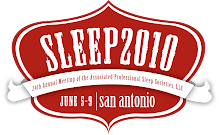 The American Academy of Sleep Medicine announced that it is sponsoring a new writing contest for high school juniors and seniors. The winning student will be recognized at SLEEP 2010 in San Antonio, Texas.
The American Academy of Sleep Medicine announced that it is sponsoring a new writing contest for high school juniors and seniors. The winning student will be recognized at SLEEP 2010 in San Antonio, Texas.The first-place prize for the 2009 – 2010 AASM High School Topical Review in Sleep Science Contest also includes a $1,000 U.S. savings bond.
To enter, students must write an original topical review paper related to sleep and sleep disorders. They can choose a topic from 12 subject areas. These include sleep deprivation, insomnia, sleep related breathing disorders and drowsy driving. Entrants must be sponsored by their science teacher.
The first-place student and one parent or guardian will receive a three-day/two-night trip to San Antonio, Texas, in June. There they will attend the SLEEP 2010 24th Annual Meeting of the Associated Professional Sleep Societies LLC from June 6 to 8, 2010.
Prizes also will be awarded for second place, third place and honorable mention. All award recipients will have their paper posted on the AASM Web site at www.sleepeducation.com. All recognized papers also will be considered for publication in the Journal of Clinical Sleep Medicine, the official publication of the AASM and a leading scientific journal in the field of sleep.




